Gamera vs. Gyaos Blu-ray Movie
HomeGamera vs. Gyaos Blu-ray Movie 
Daikaijū kūchūsen: Gamera tai GyaosuArrow | 1967 | 86 min | Not rated | No Release Date
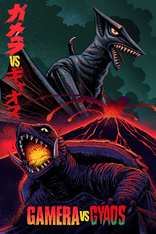
Price
Movie rating
6.1 | / 10 |
Blu-ray rating
| Users | 0.0 | |
| Reviewer | 3.0 | |
| Overall | 3.0 |
Overview
Gamera vs. Gyaos (1967)
Unusual volcanic activity in Japan awakens Gyaos, a bloodthirsty flying monster with the power to slice things in half with an ultrasonic ray. While scientists and the military scramble to devise a way to stop this new threat, a young boy forms an alliance with Gamera; a monster no one else seems to trust.
Starring: Kōjirō Hongō, Kichijirō Ueda, Reiko Kasahara, Akira Natsuki, Taro MaruiDirector: Noriaki Yuasa
| Foreign | Uncertain |
| Sci-Fi | Uncertain |
| Fantasy | Uncertain |
| Action | Uncertain |
Specifications
Video
Video codec: MPEG-4 AVC
Video resolution: 1080p
Aspect ratio: 2.35:1
Original aspect ratio: 2.35:1
Audio
Japanese: DTS-HD Master Audio Mono
English: DTS-HD Master Audio Mono (48kHz, 24-bit)
English: DTS-HD Master Audio Mono (48kHz, 24-bit)
Two English dubs; Japanese track is also 48kHz 24-bit
Subtitles
English
Discs
Blu-ray Disc
Single disc (1 BD)
Playback
Region A (B, C untested)
Review
Rating summary
| Movie | 3.0 | |
| Video | 3.0 | |
| Audio | 3.5 | |
| Extras | 3.0 | |
| Overall | 3.0 |
Gamera vs. Gyaos Blu-ray Movie Review
Reviewed by Jeffrey Kauffman October 25, 2020 Note: This version of this film is available as part of Gamera: The Complete Collection.
Theres a venerable old maxim that states whats sauce for the goose is sauce for gander, and in that regard, this deluxe Arrow release may
be
thought of as being at least kinda sorta the same sauce for an iconic kaiju that Criterions Godzilla: The Showa-Era Films, 1954-1975 was for
what is
arguably the most iconic kaiju in the annals of Japanese cinema. The Criterion release aggregated fifteen Godzilla films
ranging
from the monsters 1954 debut to Terror of Mechagodzilla
from
1975, while this collection covers the Gamera films from the 1965 debut of the creature through 2006's Gamera the Brave. The comparison between the two franchises is perhaps particularly apt in
that, as August Ragone gets into in some of the bounteous supplemental features included on
this release, Gamera was Daieis attempt to duplicate the success that Toho had had with the Godzilla films. As such, theres
an
undeniably derivative aspect to quite a few (maybe all) of the Gamera films, plus there is a perhaps equally undeniable
comedic
element in that Gamera is in essence a giant, marauding turtle, as opposed to the arguably more threatening dinosaur-like ambience of Godzilla.
Aside from the inclusion of retooled American versions of some of the films that this Arrow set offers as ostensible supplements, all of the original
versions of the twelve "Japanese" films in this set save one were included in
Gamera HD Bundle Collection from Mill Creek Entertainment several years ago, albeit with pretty shoddy technical merits according to
my colleague Martin Liebman's reviews (the parent entry for the collection does not have a separate review, but if you go to the product Overview tab, Marty has reviewed all but
one of
the films in the set linked to in the parent review). Mill Creek also released Gamera Trilogy, which Marty reviewed separately, and which includes his only review of Gamera 3: Revenge of
Iris. I'll refer to Marty's reviews in my reviews of the shared films in this set for those who want plot recaps, leaving the bulk of my
reviews to both technical assessments and detailing of the supplementary material. The one outlier that wasn't released by Mill Creek, the
aformentioned Gamera the Brave, was released by Tokyo Shock a few years ago and was reviewed at that time by Brian Orndorf, so in
my review of that particular film I'll be referring to Brian's review for plot information. As always it can also be
instructive to look at the various reviews in order to compare screenshots. I will say that I evidently have more of a soft spot for some of these
films than my colleagues, and my scores for the films reflect that opinion.
Arrow, long the champion of cult items, has outdone itself with this release, offering all of the Gamera films in a really handsomely
appointed
package that includes a glut of both on disc bonus features as well as accompanying non-disc swag (the disc related supplements are detailed in
the
individual reviews of each film, while the non-disc supplements are listed in the
Gamera: The Complete Collection Blu-ray review).
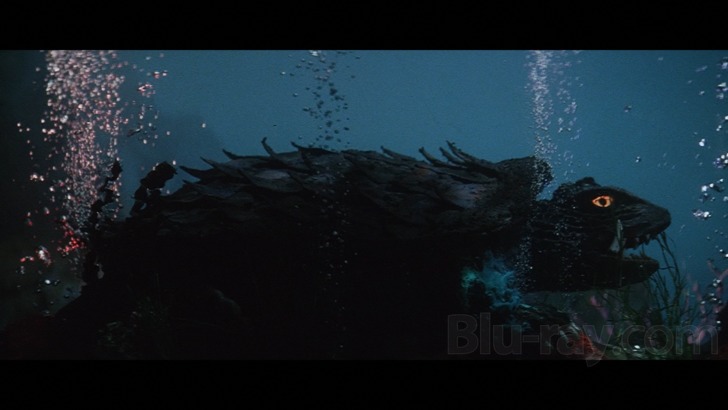
As with many of the films in this set, this film was part of the Mill Creek Entertainment release from several years ago. For those interested in a plot recap, I refer you to Martin Liebman's Gamera vs. Gyaos Blu-ray review of that version.
Gamera vs. Gyaos Blu-ray Movie, Video Quality 
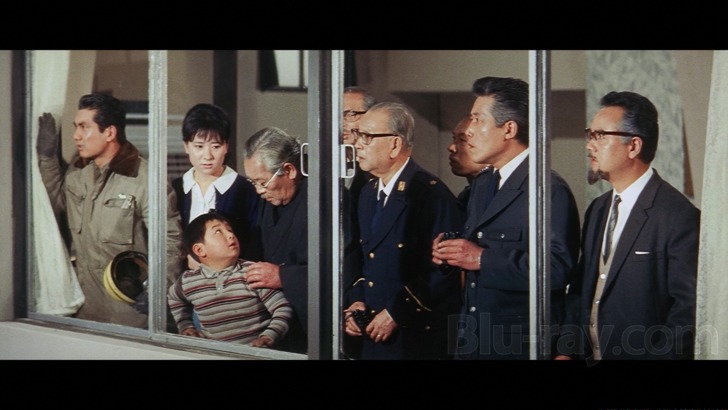
Gamera vs. Gyaos is presented on Blu-ray courtesy of Arrow Video with an AVC encoded 1080p transfer in 2.35:1. Arrow's oversized booklet containing information on the films lumps the entire series together in its descriptions of the transfers:
The masters for all twelve original Japanese films were prepared and supplied to Arrow Films by the Kadokawa Corporation. Gamera the Guardian of the Universe, Gamera 2: Attack of Legion, and Gamera 3: Revenge of Iris were restored in 4K by Kadokawa and approved by director Shusuke Kaneko in 2015.This, along with a couple of the subsequent entries in this collection, has a somewhat dated appearance. While the palette is still generally decently suffused, it doesn't quite pop with the immediacy of Gamera vs. Barugon. Grain is quite heavy throughout the presentation and verges on noise territory, especially against some of the brighter backgrounds like skies. Fading tends to skew reds toward slightly brownish oranges, but blues and greens especially are still quite vivid and help the forest scenes achieve some authenticity. Detail levels are generally quite good, revealing precise aspects on fabrics of costumes or even the bark on trees. This presentation looks rather soft quite a bit of the time, and there are actually some moments that actually look out of focus.
Original 16mm and 35mm materials relating to the English language versions originally distributed in the United States by American International and Filmways were accessed through the kind courtesy of Metro Goldwyn Mayer, in association with the Kadokawa Corporation. The English dubbed audio was restored from the original magnetic and optical tracks by Deluxe, who also conformed it to the Japanese masters. Some additional 16mm materials were sourced from UCLA Film Archive. The film elements, which include English language credit sequences, insert shots and trailers, were scanned at EFilm and restored at R3Store Studios. Additional English language materials for the series were kindly supplied by Shout! Factory, ADV Films and Media Blasters, with additional thanks to Paulie Senkawsky and Will Offutt.
For Gammera the Invincible, the American theatrical version of Gamera, the Giant Monster, attempts were made to access the original negative held at UCLA Film Archive, but this is no longer legally accessible. A 35mm exhibition print was scanned in high definition by Legend Films, who provided this HD master to Arrow. This print was missing some shots of a jet pilot at the start of the film, and another film source for these shots could not be found. To insure an uncut presentation, these missing shots were reintegrated into the master using the HD master for Gamera, the Giant Monster for the video and an analog tape master for the dubbed English audio. As a result, some of these shots have burnt in Japanese subtitles that did not feature on the original American theatrical release and could not be removed here; we hope these do not affect your enjoyment of the film. Additional restoration took place at R3Store Studios.
Gamera vs. Gyaos Blu-ray Movie, Audio Quality 
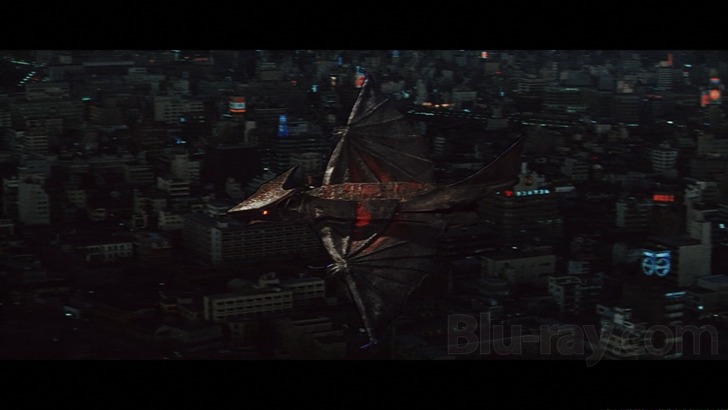
This is another offering in this set which features both AITV and Daiei dubs in English, both presented in DTS-HD Master Audio Mono, as well as the original Japanese language track, also presented in DTS-HD Master Audio Mono. I once again spent most of my time on the original language track, which delivers dialogue and effects decently, though there is some very slight distortion at both ends of the spectrum, with both extreme highs and lows showing minimal signs of distortion. I once again found the Daiei dub to be boxier sounding than the AITV dub. Optional English subtitles are available.
Gamera vs. Gyaos Blu-ray Movie, Special Features and Extras 
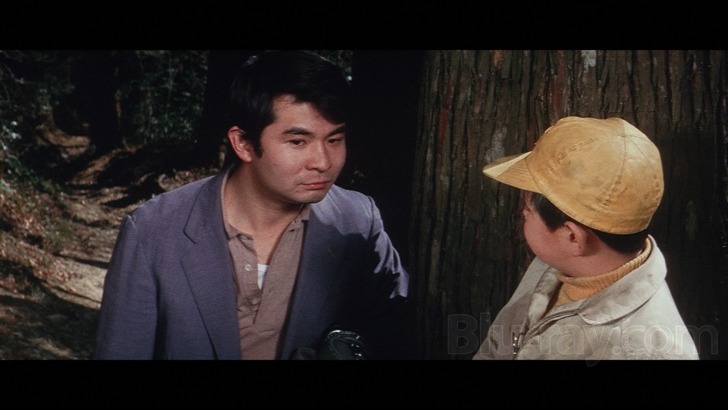
- Introduction by August Ragone (1080p; 9:12)
- Commentary by Stuart Galbraith IV
- Alternate English Credits
- American International version (1080p; 1:17)
- American International alternate footage (1080p; 1:10) is kind of a weird little supplement that shows two brief shots of signs that were redone with English signage. Some introductory text suggests these were anamorphically squeezed for television broadcast, and which are presented here in both 1.33:1 and 2.35:1 so that anyone who has been consumed with this conundrum can decide which looks best. I frankly think they look "more natural" (to use Arrow's verbiage in the introductory text) in 1.33:1, much as I did with the two different aspect ratios of the American International credits sequence offered on Gamera vs. Barugon.
- Sandy Frank version (1080p; 4:34)
- Theatrical Trailers
- Japanese Trailer (1080p; 2:29)
- German Trailer (1080p; 2:18)
- US TV Spot (1080p; 1:08)
- US Video Promo (1080p; 00:52)
- Image Gallery (1080p; 21:31)
Gamera vs. Gyaos Blu-ray Movie, Overall Score and Recommendation 
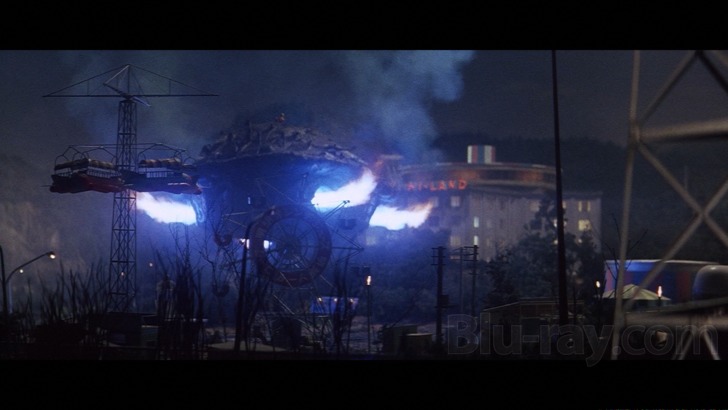
This is probably the point in the Gamera franchise where the creative staff just decided to give in and make this a series aimed at least largely at kids, and as such, some of its goofier aspects simply need to be accepted at face value. Video and audio both have occasional issues, but the supplementary package is excellent.
Similar titles
Similar titles you might also like
(Still not reliable for this title)

Gamera vs. Viras
Gamera tai uchu kaijū Bairasu / Destroy All Planets
1968

Gamera vs. Jiger
Gamera tai Daimaju Jaiga
1970

Gamera
Daikaijū Gamera / Gamera, the Giant Monster
1965

Gamera vs. Barugon
Daikaijū kettō: Gamera tai Barugon
1966

Gamera: Super Monster
Uchu kaijū Gamera
1980

Gamera vs. Guiron
Gamera tai daiakuju Giron
1969

Gamera vs. Zigra
Gamera tai Shinkai kaijū Jigura
1971

Gamera the Brave
2006

Gamera 3: Revenge of Iris
1999

Gamera: Guardian of the Universe
Gamera daikaijū kuchu kessen
1995

Gammera 3D
High Frame Rate Edition
1966

Gamera 2: Attack of the Legion
Gamera 2: Region shurai
1996

Godzilla vs. the Smog Monster
ゴジラ対ヘドラ / Gojira tai Hedora / Godzilla vs. Hedorah
1971

Godzilla 2000
ゴジラ2000 ミレニアム / Gojira ni-sen mireniamu / Godzilla 2000: Millennium
1999

Godzilla, Mothra and King Ghidorah: Giant Monsters All-Out Attack
ゴジラ・モスラ・キングギドラ 大怪獣総攻撃 / Gojira, Mosura, Kingu Gidorā: Daikaijū sōkōgeki
2001

Godzilla and Mothra: The Battle for Earth
ゴジラvsモスラ / Gojira vs. Mosura / Godzilla vs. Mothra
1992

Godzilla vs. Biollante
ゴジラvsビオランテ / Gojira vs. Biorante
1989

Mothra vs. Godzilla
モスラ対ゴジラ / Mosura tai Gojira
1964

Godzilla Raids Again
ゴジラの逆襲 / Gojira no gyakushū
1955

King Kong vs. Godzilla
キングコング対ゴジラ / Kingu Kongu tai Gojira / 1962 Japanese version
1962
